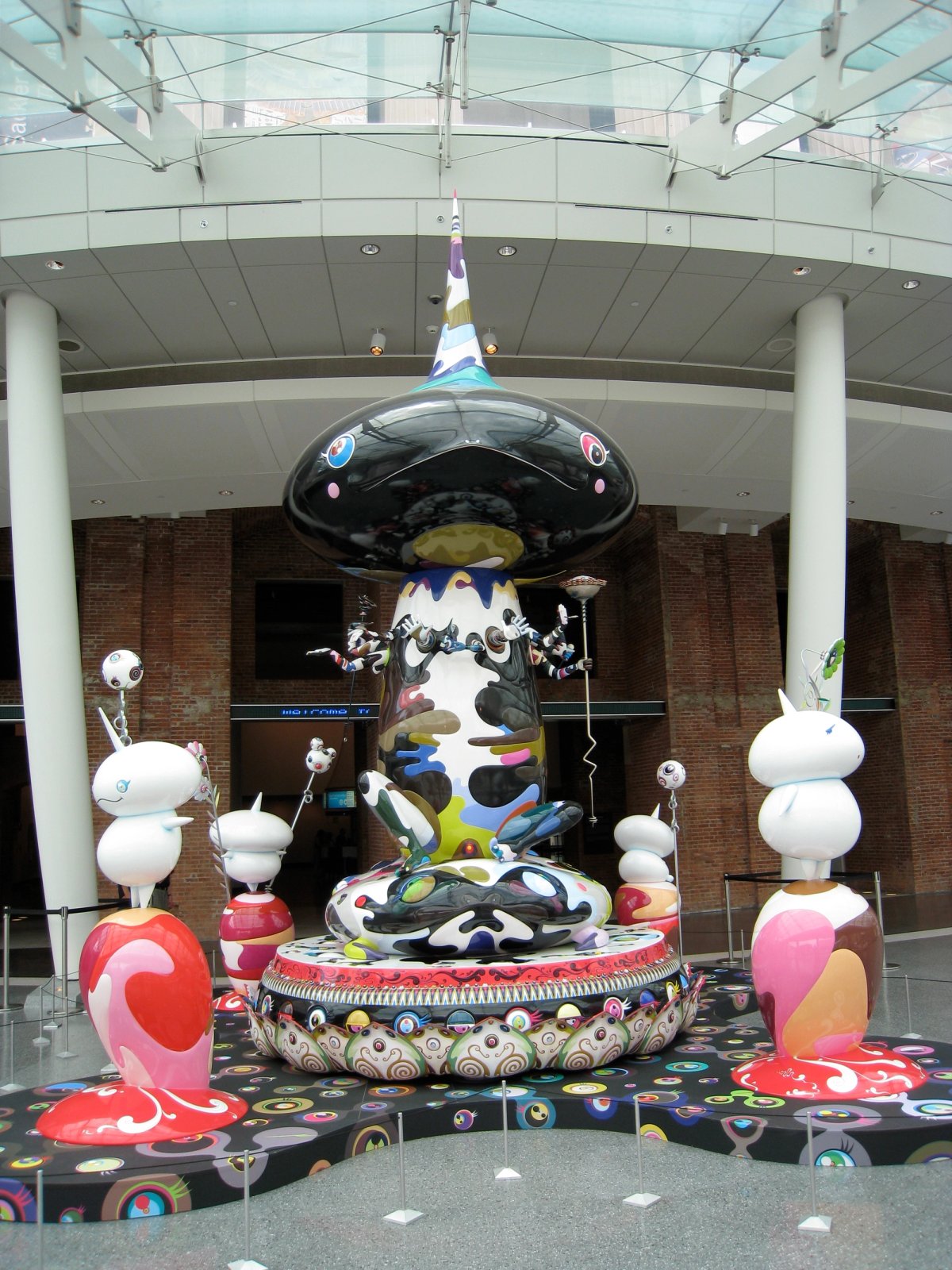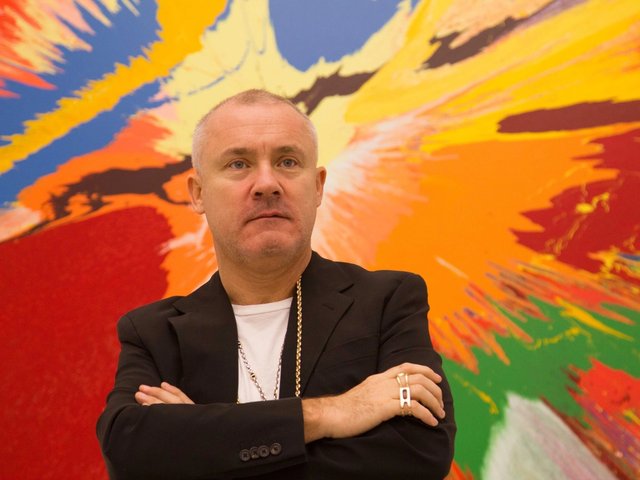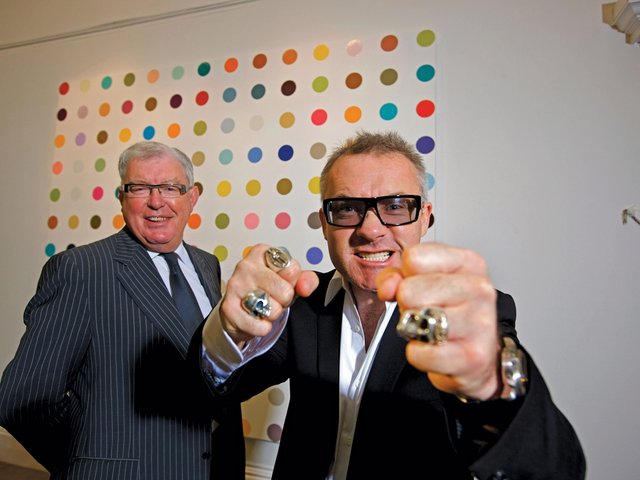“People come to me and ask: ‘What can I sell this Damien Hirst for?’ And I simply can not find a market for him. He’s the only artist I’m finding has no market right now,” observed New York dealer Asher Edelman at the beginning of the year. Just three months earlier, the artist had offered 223 works fresh from the studio at Sotheby’s London in an auction entitled Beautiful Inside My Head Forever (15-16 September 2008). All but five of the lots sold over two days and the firm reported an auction total of a staggering £111.4m. The sale—which began on the very day Lehman Brothers filed for Chapter 11 bankruptcy and the Dow Jones dropped 500 points—seemed strangely immune from the realities of the financial meltdown.
Then, everything changed. The collapse of the contemporary art market this year has been brutal—prices are down by around 50% for most artists compared with the market peak in 2008. Galleries have gone out of business in New York and London, and Christie’s and Sotheby’s have slashed the size of their contemporary art sales as they struggle to find consignments. This May, Sotheby’s contemporary art auction in New York made $47m compared with $362m a year earlier, a drop of 87%.
However, the contemporary art crash was not Hirst’s only problem. The artist’s Sotheby’s auction, hailed as a huge success at the time, quickly came to be seen as the catalyst for a severe loss of confidence in the artist.
“The Sotheby’s sale suddenly made it clear that Damien had become a conceptual businessman as opposed to the conceptual artist he was in the early days. The emperor’s clothes are off for all the world to see,” Edelman says.
As Tate Modern opens an exhibition examining the relationship between contemporary art and commerce, Pop Life: Art in a Material World (1 October-17 January 2010), we consider the recent market history of Hirst and that of Takashi Murakami—artists who turned themselves into brands by maximising commercial opportunities and adopting marketing strategies previously reserved for the sale of luxury goods.
Increased production
“The problem with the Sotheby’s sale”, is that the works on offer were “manufactured” and not “made” by Hirst, notes Edelman, referring both to the artist’s use of large teams of assistants to create work for the auction and the repetition of familiar themes and ideas in the art itself.
“You have to consider the number of similar and identical pieces Hirst produced and the lack of limitation on editions. Even Andy [Warhol] had a limit to how many pieces he would make. You can make a lot of sharks but you will end up with a shark factory. Ultimately these will have no value,” says Edelman.
“Even Andy [Warhol] had a limit to how many pieces he would make. You can make a lot of sharks but you will end up with a shark factory. Ultimately these will have no value”Asher Edelman, dealer
As new money poured into the contemporary art market while it moved towards its peak in 2008, Hirst responded to the demand for his work by significantly increasing his production levels with the assistance of some 150 employees distributed across several studios.
While the volume of private sales is difficult to judge, Hirst’s auction turnover increased significantly year on year. In 2006, 167 of his works were offered at auction, by 2008 the number had risen to 624, including the 223 lots consigned directly by the artist himself at Sotheby’s Beautiful sale.
The reprise of familiar themes, such as the artist’s iconic shark in formaldehyde—originally produced for Charles Saatchi in 1991, who exhibited the work in his 1997 Sensation show, before selling it to US hedge fund billionaire Steve Cohen for $8m in 2005—enabled new collectors entering the market to own a Hirst work that was famous around the world, in short to buy into “brand Hirst”. But did the repetition dilute the value of the “original shark” as Edelman believes?
Sandy Heller, the art adviser who works with Cohen, believes “there is only one shark”. He adds: “Ours was made in 1991—Damien waited another 12 years before making another one. He has gone through a very prolific period in the last few years. Ever since the Pharmacy sale [fittings from Hirst’s Notting Hill restaurant were auctioned at Sotheby’s in 2004 for £11.1m] his output has increased ten times but the issue for me is that he’s a great artist. Warhol produced hundreds of works—he’s still a great artist. I don’t think you’ll ever regret buying a work by Damien Hirst, although you may temporarily regret how much you had to pay for it. However, over time, that will figure itself out.”
The Murakami market
Prices for the manga- and anime-inspired sculptures and paintings of Takashi Murakami have also declined by around 50% in the last 18 months, in line with the rest of the contemporary art market. A year ago, the artist’s 2003-04 Tongari-kun fibreglass sculpture, known as “Mr Pointy”, estimated at £3.5m to £4.5m, was bought in at Phillips in London. His Los Angeles dealer, Timothy Blum of Blum & Poe says: “after Mr Pointy failed to sell…people were looking for a fall but it’s comical when they say [Murakami] is in deep shit. Not so. The timing and the scale of the [very big] piece were all wrong.”
Like Hirst—who Murakami cites as a key influence—Murakami’s prices rose quickly in the booming years of the market. His auction career only started in 2000, when one sale is recorded, at $2,105—but increased rapidly in value to more than $3m in 2004 when the average sale price reached $88,330. After a dip in 2005-06, prices climbed steeply to 2008, when 395 works were offered at auction, 79 of them finding buyers for an average of over $450,000.
The apotheosis came in May 2008 when My Lonesome Cowboy (1998) a fibreglass sculpture of a naked, spiky-haired youth waving a lasso of his own semen, sold for $15.16m at Sotheby’s New York, setting an auction record for the artist.
Record auction prices were set in the same year for Damien Hirst (The Golden Calf, £10.35m at his Beautiful sale at Sotheby’s London in September); Jeff Koons (Balloon Flower—Magenta, £12.92m at Christie’s London in June) and Richard Prince (Overseas Nurse, £4.24m at Sotheby’s London in July).
“The prices in 2008 for Murakami, Hirst, Koons and Prince were historical prices for artists with little history,” notes the London-based dealer Kenny Schachter. Such prices are inconceivable today, say dealers.
The boom in the art market, driven by colossal liquidity from financial services, energy, property and other sources of wealth, and an influx of buyers from newly rich countries such as Russia and the Middle East, was mirrored in the demand for luxury goods such as yachts and helicopters. It was fuelled by a craze for private museums, all of which were stocked with the “brand names” of contemporary creation.
Two art market insiders told The Art Newspaper that Murakami’s Lonesome Cowboy, which went to a private museum in Ukraine, would probably fetch just $6m if sold now. “But prices had risen so high in 2007-08, and one needs to realise that $6m is still an enormous amount of money,” notes New York dealer Marianne Boesky who represented Murakami until 2005 when he joined Gagosian Gallery.
“Prices are down for Murakami, of course, but it’s not a one-size-fits-all price reduction,” believes the New York art adviser Todd Levin. “The so called ‘most iconic’ pieces are probably down by a factor of 50%, but will still sell. On the other hand, lesser pieces, such as average paintings, are having a hard time finding a market at any price,” he explains.
The same discrimination is taking place with Hirst, say observers. Asher Edelman notes that ten months after the collapse of confidence in the artist’s market, “I see some interest in the earlier work, but nothing for the later work.” Philip Hoffman, the chief executive of the Fine Art Fund, agrees: “We have taken an interest in early Hirst from the 1990s, and specifically unique works, but I would never advocate buying pieces from the later stages in his career when he started producing many versions of works he’d already made. A UK collector recently offered me a big spin painting for 40% below the price he had paid for it. We turned it down.”
Ironically, it is the auction houses which have played a key part in re-establishing a degree of confidence in the Hirst market. After three works by the artist failed to sell at a Sotheby’s auction in Doha, Qatar in March, both Christie’s and Sotheby’s restricted the number of Hirst lots at their subsequent contemporary auctions.
After three works by the artist failed to sell at a Sotheby’s auction in Doha, Qatar in March, both Christie’s and Sotheby’s restricted the number of Hirst lots at their subsequent contemporary auctions
The strategy has paid off according to Anders Petterson of the London-based research group ArtTactic who notes that “much of the uncertainty around the impact of the massive Sotheby’s sale, has been reduced—as fewer works are finding their way to auction, and the ones that do have performed reasonably well”. Likewise, the first half of 2009 saw Murakami volumes well down—though it is hard to say whether this was a deliberate auction house strategy or simply a result of the works available for sale. Buy-in rates were also well up. The total volume of Murakami sales in 2008 was over $36.1m, but slumped to just $2.2m in the first six months of 2009.
Business as usual?
So where does the collapse of prices leave Hirst and Murakami? Hirst has announced the end of his signature spot, spin, and butterfly paintings as well as his drug cabinets. He also told the Observer newspaper last month that he no longer intends to produce “the big statement stuff” and said that he believed there were “five great pieces” in his Sotheby’s Beautiful sale—“the diamond skull [not actually offered as part of the auction]; the fly piece; the shark…the golden calf [and]...the unicorn piece”—a statement which may worry the buyers of the other 219 lots. He also revealed that he now believes conceptual art is a “total dead end”.
Hirst has reduced the number of assistants he employs from 150 to around 70 and has returned to painting with his own hand; a selection of his recent canvases go on display at the Wallace Collection in London later this month. His London gallery White Cube is also hosting an exhibition of new paintings in its two galleries in Mason’s Yard and Hoxton Square from 25 November until 30 January 2010.
Meanwhile, Murakami has cancelled the third Geisai art fair at Art Basel Miami Beach this December, which he funded. According to sources in the art world, he has also reduced the number of his assistants, although this could not be independently verified.
The artist currently has two exhibitions: a large four-panel canvas depicting the legend of the Karajishi, the mythological animal that guards the thresholds of Japanese Buddhist temples, is on display at Gagosian West 24th Street in New York (until 24 October) while in Paris, the artist’s French dealer Emmanuel Perrotin, is showing Self-portraits, a series of new paintings and sculptures (until 17 October) with prices ranging from $150,000 to $2.2m. Perrotin says that 90% of the 23 works were sold before the opening.
It has also been announced that Murakami will have a show at Versailles next year, following on from Jeff Koons and the French artist Xavier Veilhan. The exhibition, in such a prestigious venue, will undoubtedly give collectors confidence and help boost prices for the artist. The royal family of Qatar is in talks with the Palace of Versailles to sponsor the exhibition. The Al-Thani family, who have recently started buying contemporary art, were also revealed as the buyers of Hirst’s 2002 painted pill cabinet, Lullaby Spring, for which they paid £9.65m ($19.1m) at Sotheby’s London in June 2007.
The branding of art
The appeal of both Hirst and Murakami to new collectors in the Gulf is symptomatic of the artists’ unique place in the contemporary art market. “They are the only two contemporary artists who have successfully turned themselves into living brands,” says Louisa Buck, The Art Newspaper’s contemporary art critic. This gives both artists a global reach that is unique.
“They are the only two contemporary artists who have successfully turned themselves into living brands”Louisa Buck, critic
Successful branding means that buyers new to the art world instantly recognise the work of Hirst and Murakami. The contemporary art boom of the past few years was largely fuelled by inexperienced buyers from the Gulf, such as the Al-Thanis, and from the ex-Soviet states such as Victor Pinchuk, the Ukrainian billionaire collector who runs his own private museum in Kiev and has amassed large collections of work by Damien Hirst and Takashi Murakami.
“Never underestimate how insecure buyers are about contemporary art, and how much they always need reassurance,” notes the economist Don Thompson in his 2008 book The $12m Stuffed Shark. “They are not willing to spend the time required to educate themselves to the point of overcoming insecurity.” Artists with a recognisable signature style such as Hirst and Murakami reassure new buyers that they are purchasing works with a proven track record.
Successful branding penetrates the market at every level. A crucial factor to both the Hirst and the Murakami enterprises is the availability of products at every price—a feature of luxury goods brands such as Prada, which offers a range of items from the relatively inexpensive, such as sunglasses, to haute couture.
At the lower end of the market, Hirst’s merchandising company Other Criteria, which runs shops in Bond Street and Marylebone, and which has just opened a New York space in collaboration with Gagosian Gallery, sells a range of material by the artist (including T-shirts, limited-edition prints, posters, books, jewellery and deckchairs) as well as work by other artists.
Meanwhile, Murakami’s commercial projects, such as his handbag designs for Louis Vuitton and his music video for Kanye West, have helped him reach entirely new audiences. His Kaikai Kiki Co, a large-scale art production and management company, makes items such as keyrings that cost as little as $22 and are currently available at Perrotin’s Paris exhibition alongside the $2.2m paintings.
Connoisseurship be damned, all today’s collector needs is a tape measure and a subscription to artnet.com
Finally, branding flattens out one of the aspects of the art market that used to make it impenetrable to newcomers. At one time, rarity in art was prized, but this also meant that comparisons were impossible, as no two works of art were the same. Today, it’s the contrary—buyers are reassured by the fact that they have an easily identifiable and recognisable work, by a well-known name, and that very similar examples hang in major private or public collections. They can even track the prices on the internet and establish values for their works. Connoisseurship be damned, all today’s collector needs is a tape measure and a subscription to artnet.com.
• Pop Life: Art in a Material World is at Tate Modern, London, 1 October-17 January 2010; No Love Lost: Blue Paintings by Damien Hirst is at the Wallace Collection, London, 14 October-24 January 2010




